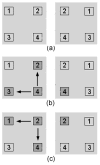Asymmetrical ground impact of the hands after a trip-induced fall: experimental kinematics and kinetics
- PMID: 17888549
- PMCID: PMC2099579
- DOI: 10.1016/j.clinbiomech.2007.07.014
Asymmetrical ground impact of the hands after a trip-induced fall: experimental kinematics and kinetics
Abstract
Background: Distal radius fractures are among the most common fall-related fractures. The manner in which the upper extremities are used for protection during a fall may exert a considerable influence on the incidence of injury. Here, we sought to determine the degree to which the assumption of sagittal plane symmetry was valid in unexpected falls after a trip, and to quantify the effects of asymmetrical upper extremity motion on impact kinematics and kinetics.
Methods: The motion of eight healthy older women who fell after being unexpectedly tripped was quantified. Impact kinematics and kinetics of 36 adults who intentionally fell onto force plates with their hands positioned either symmetrically or asymmetrically were quantified.
Findings: Just prior to safety harness engagement the wrists of the older women were not positioned or moving symmetrically relative to the midpoint between the shoulders. Asymmetry did not affect the peak reaction force magnitude, but increased the degree to which force was directed along the axis of the radius (axial component of the unit vector k = 0.949 versus k = 0.932, P = 0.026). Asymmetry resulted in greater wrist dorsiflexion (47 degrees versus 43 degrees , P = 0.019) compared to symmetrical trials and increased temporal offset (33 ms versus 11 ms, P<0.001) between right and left ground impacts.
Interpretation: Kinetics and kinematics arising from asymmetric impact may meaningfully affect the fracture strength of the distal radius. Because trip-induced falls in older women may result in asymmetric upper extremity impact, these differences in landing kinematics and kinetics due to asymmetry merit consideration when developing clinical interventions to prevent fall-related fractures.
Figures




Similar articles
-
Fall arrest strategy affects peak hand impact force in a forward fall.J Biomech. 2002 Jun;35(6):843-8. doi: 10.1016/s0021-9290(02)00011-8. J Biomech. 2002. PMID: 12021005
-
The effect of static muscle forces on the fracture strength of the intact distal radius in vitro in response to simulated forward fall impacts.J Biomech. 2014 Aug 22;47(11):2672-8. doi: 10.1016/j.jbiomech.2014.05.010. Epub 2014 May 23. J Biomech. 2014. PMID: 24927979
-
On reducing hand impact force in forward falls: results of a brief intervention in young males.Clin Biomech (Bristol). 2003 Oct;18(8):730-6. doi: 10.1016/s0268-0033(03)00124-4. Clin Biomech (Bristol). 2003. PMID: 12957559 Clinical Trial.
-
The effect of asymmetrical body orientation during simulated forward falls on the distal upper extremity impact response of healthy people.J Electromyogr Kinesiol. 2017 Apr;33:48-56. doi: 10.1016/j.jelekin.2017.01.006. Epub 2017 Jan 27. J Electromyogr Kinesiol. 2017. PMID: 28183042
-
Are Volar Locking Plates Superior to Percutaneous K-wires for Distal Radius Fractures? A Meta-analysis.Clin Orthop Relat Res. 2015 Sep;473(9):3017-27. doi: 10.1007/s11999-015-4347-1. Epub 2015 May 16. Clin Orthop Relat Res. 2015. PMID: 25981715 Free PMC article. Review.
Cited by
-
Pressure distribution over the palm region during forward falls on the outstretched hands.J Biomech. 2011 Feb 3;44(3):532-9. doi: 10.1016/j.jbiomech.2010.09.011. Epub 2010 Oct 28. J Biomech. 2011. PMID: 21035120 Free PMC article.
-
Age and gender effects on the proximal propagation of an impulsive force along the adult human upper extremity.Ann Biomed Eng. 2014 Jan;42(1):25-35. doi: 10.1007/s10439-013-0900-9. Epub 2013 Aug 27. Ann Biomed Eng. 2014. PMID: 23979475 Free PMC article. Clinical Trial.
-
Protective arm movements are modulated with fall height.J Biomech. 2020 Jan 23;99:109569. doi: 10.1016/j.jbiomech.2019.109569. Epub 2019 Dec 16. J Biomech. 2020. PMID: 31898976 Free PMC article.
-
The timing and amplitude of the muscular activity of the arms preceding impact in a forward fall is modulated with fall velocity.J Biomech. 2023 Mar;150:111515. doi: 10.1016/j.jbiomech.2023.111515. Epub 2023 Feb 24. J Biomech. 2023. PMID: 36867953 Free PMC article.
-
Regional variations of gender-specific and age-related differences in trabecular bone structure of the distal radius and tibia.Bone. 2010 Jun;46(6):1652-60. doi: 10.1016/j.bone.2010.02.021. Epub 2010 Feb 25. Bone. 2010. PMID: 20188877 Free PMC article.
References
-
- Augat P, Iida H, Jiang Y, Diao E, Genant HK. Distal radius fractures: mechanisms of injury and strength prediction by bone mineral assessment. J Orthop Res. 1998;16:629–35. - PubMed
-
- Bherer L, Belleville S, Hudon C. Executive function deficits in normal aging, Alzheimer’s disease, and frontotemporal dementia. Psychol Neuropsychiatr Vieil. 2004;2:181–9. - PubMed
-
- Centers for Disease Control and Prevention (CDC) Hyattsville, MD: U.S. Department of Health and Human Services, Centers for Disease Control and Prevention; 1994. National Center for Health Statistics (NCHS). National Health and Nutrition Examination Survey Data. http://www.cdc.gov/nchs/about/major/nhanes/Anthropometric%20Measures.htm.
-
- Chiu J, Robinovitch SN. Prediction of upper extremity impact forces during falls on the outstretched hand. J Biomech. 1998;31:1169–76. - PubMed
-
- Chou PH, Chou YL, Lin CJ, Su FC, Lou SZ, Lin CF, Huang GF. Effect of elbow flexion on upper extremity impact forces during a fall. Clin Biomech (Bristol, Avon) 2001;16:888–94. - PubMed
Publication types
MeSH terms
Grants and funding
LinkOut - more resources
Full Text Sources
Medical

